Identification of Materials and Kirazuri Decorative Technique in Japanese Ukiyo-e Prints Using Non-Invasive Spectroscopic Tools
Abstract
1. Introduction
The Japanese Art of Woodblock Prints
2. Materials and Methods
2.1. Reflectance Spectroscopy
2.2. Imaging Analysis
- -
- A modified Nikon D90 full-spectrum camera (sensitivity extended to ~1000 nm), equipped with a CMOS sensor (12.3 MP, 23.6 × 15.8 mm) and a high-pass interference filter (850 nm) for near-infrared (NIR) reflectography.
- -
- A Nikon D7200 DSLR with a UV-blocking filter and a yellow long-pass filter for ultraviolet-induced visible fluorescence imaging. This camera featured a CMOS sensor (24.2 MP, 23.6 × 15.8 mm).
2.3. External Reflection Infrared Spectroscopy
3. Results and Discussion
3.1. Investigation of External Reflection FTIR and Visible Reflectance Spectroscopy on Prints
3.2. Investigation of Visible Fluorescence Induced by UV Radiation on Prints
4. Conclusions
Supplementary Materials
Author Contributions
Funding
Data Availability Statement
Acknowledgments
Conflicts of Interest
References
- Hillier, J.R. The Art of the Japanese Book; Sotheby’s Publications: London, UK, 1987. [Google Scholar]
- Hillier, J.R. Japanese Colour Prints; Phaidon: London, UK, 1991. [Google Scholar]
- Lane, R. Images from the Floating World: The Japanese Print; Dorset Press: New York, NY, USA, 1978. [Google Scholar]
- Takahashi, S. Traditional Woodblock Prints of Japan; Heibonsha: Tokyo, Japan, 1976; Volume 22. [Google Scholar]
- Marks, A. Publishers of Japanese Woodblock Prints: A Compendium; Hotei Publishing: Amsterdam, The Netherlands, 2011. [Google Scholar]
- Marks, A. Japanese Woodblock Prints: Artists, Publishers and Masterworks: 1680-1900; Tuttle Publishing: Tokyo, Japan, 2010; ISBN 1462905994. [Google Scholar]
- Salter, R. Japanese Woodblock Printing; University of Hawaii Press: Honolulu, Hawaii, 2002; ISBN 0824825535. [Google Scholar]
- Benedetti, D.P.; Zhang, J.; Tague, T.J.; Lombardi, J.R.; Leona, M. In Situ Microanalysis of Organic Colorants by Inkjet Colloid Deposition Surface-enhanced Raman Scattering. J. Raman Spectrosc. 2014, 45, 123–127. [Google Scholar] [CrossRef]
- Cesaratto, A.; Leona, M.; Pozzi, F. Recent Advances on the Analysis of Polychrome Works of Art: SERS of Synthetic Colorants and Their Mixtures With Natural Dyes. Front. Chem. 2019, 7, 105. [Google Scholar] [CrossRef] [PubMed]
- Edwards, G.; Villafana, T. Multi-Analytic Characterization of Colorants in Two Impressions of an Utagawa Toyoharu Perspective Print. J. Cult. Herit. 2020, 45, 48–58. [Google Scholar] [CrossRef]
- Huang, J. A Technical Study of A Painting by Suzuki Harunobu at the Museum of Fine Arts, Boston: Artist’s Palette and Techniques. Book. Pap. Group. Annu. 2007, 26, 151–153. [Google Scholar]
- Kissell, L.N.; Quady, T.K.; Durastanti, D.; Springer, S.; Kenmotsu, J.; Clare, T.L. A Multi-Analytical Approach to Identify Red Colorants on Woodblock Prints Attributed to Suzuki Harunobu. Herit. Sci. 2022, 10, 94. [Google Scholar] [CrossRef]
- Leona, M.; Decuzzi, P.; Kubic, T.A.; Gates, G.; Lombardi, J.R. Nondestructive Identification of Natural and Synthetic Organic Colorants in Works of Art by Surface Enhanced Raman Scattering. Anal. Chem. 2011, 83, 3990–3993. [Google Scholar] [CrossRef]
- Sakamoto, A.; Ochiai, S.; Higashiyama, H.; Masutani, K.; Kimura, J.; Koseto-Horyu, E.; Tasumi, M. Raman Studies of Japanese Art Objects by a Portable Raman Spectrometer Using Liquid Crystal Tunable Filters. J. Raman Spectrosc. 2012, 43, 787–791. [Google Scholar] [CrossRef]
- Vermeulen, M.; Burgio, L.; Vandeperre, N.; Driscoll, E.; Viljoen, M.; Woo, J.; Leona, M. Beyond the Connoisseurship Approach: Creating a Chronology in Hokusai Prints Using Non-Invasive Techniques and Multivariate Data Analysis. Herit. Sci. 2020, 8, 62. [Google Scholar] [CrossRef]
- Vermeulen, M.; Leona, M. Evidence of Early Amorphous Arsenic Sulfide Production and Use in Edo Period Japanese Woodblock Prints by Hokusai and Kunisada. Herit. Sci. 2019, 7, 73. [Google Scholar] [CrossRef]
- Zaleski, S.; Takahashi, Y.; Leona, M. Natural and Synthetic Arsenic Sulfide Pigments in Japanese Woodblock Prints of the Late Edo Period. Herit. Sci. 2018, 6, 32. [Google Scholar] [CrossRef]
- Connors, S.A.; Whitmore, P.M.; Keyes, R.S.; Coombs, E.I. The Identification and Light Sensitivity of Japanese Woodblock Print Colorants: The Impact on Art History and Preservation. In Scientific Research on the Pictorial Art of Asia. Second Fobers Symposium at the Freer Gallery of Art London; Archetype Publications Ltd.: London, UK, 2005; pp. 35–47. [Google Scholar]
- Derrick, M.; Newman, R.; Wright, J. Characterization of Yellow and Red Natural Organic Colorants on Japanese Woodblock Prints by EEM Fluorescence Spectroscopy. J. Am. Inst. Conserv. 2017, 56, 171–193. [Google Scholar] [CrossRef]
- Feller, R.L.; Curran, M.; Bailie, C. Identification of Traditional Organic Colorants Employed in Japanese Prints and Determination of Their Rates of Fading. In Japanese Woodblock Prints: A Catalogue of the Mary A. Ainsworth Collection; Keyes, R.S., Allen Memorial Art Museum, Eds.; Allen Memorial Art Museum, Oberlin College; Indiana University Press: Oberlin, OH, USA; Bloomington, IN, USA, 1984; ISBN 978-0942946017. [Google Scholar]
- Nakamura, R.; Tanaka, Y.; Ogata, A.; Naruse, M. Dye Analysis of Shosoin Textiles Using Excitation−Emission Matrix Fluorescence and Ultraviolet−Visible Reflectance Spectroscopic Techniques. Anal. Chem. 2009, 81, 5691–5698. [Google Scholar] [CrossRef]
- Pérez-Arantegui, J.; Rupérez, D.; Almazán, D.; Díez-de-Pinos, N. Colours and Pigments in Late Ukiyo-e Art Works: A Preliminary Non-Invasive Study of Japanese Woodblock Prints to Interpret Hyperspectral Images Using in-Situ Point-by-Point Diffuse Reflectance Spectroscopy. Microchem. J. 2018, 139, 94–109. [Google Scholar] [CrossRef]
- Shimoyama, S.; Matsui, H.; Shimoyama, Y. Non-Destructive Identification of Blue Colorants in Ukiyo-e Prints by Visible-Near Infrared Reflection Spectrum Obtained with a Portable Spectrophotometer Using Fiber Optics. Bunseki Kagaku 2006, 55, 121–126. [Google Scholar] [CrossRef][Green Version]
- Whitmore, P.M.; Cass, G.R. The Ozone Fading of Traditional Japanese Colorants. Stud. Conserv. 1988, 33, 29. [Google Scholar] [CrossRef]
- Leona, M.; Winter, J. Fiber Optics Reflectance Spectroscopy: A Unique Tool for the Investigation of Japanese Paintings. Stud. Conserv. 2001, 46, 153. [Google Scholar] [CrossRef]
- Cañamares, M.V.; Mieites-Alonso, M.G.; Leona, M. Fourier Transform-Raman and Surface-enhanced Raman Spectroscopy Analysis of Safflower Red-dyed Washi Paper: PH Study and Bands Assignment. J. Raman Spectrosc. 2020, 51, 903–909. [Google Scholar] [CrossRef]
- Cesaratto, A.; Luo, Y.-B.; Smith, H.D.; Leona, M. A Timeline for the Introduction of Synthetic Dyestuffs in Japan during the Late Edo and Meiji Periods. Herit. Sci. 2018, 6, 22. [Google Scholar] [CrossRef]
- Minamikawa, T.; Nagai, D.; Kaneko, T.; Taniguchi, I.; Ando, M.; Akama, R.; Takenaka, K. Analytical Imaging of Colour Pigments Used in Japanese Woodblock Prints Using Raman Microspectroscopy. J. Raman Spectrosc. 2017, 48, 1887–1895. [Google Scholar] [CrossRef]
- Biron, C.; Le Bourdon, G.; Pérez-Arantegui, J.; Servant, L.; Chapoulie, R.; Daniel, F. Probing Some Organic Ukiyo-e Japanese Pigments and Mixtures Using Non-Invasive and Mobile Infrared Spectroscopies. Anal. Bioanal. Chem. 2018, 410, 7043–7054. [Google Scholar] [CrossRef] [PubMed]
- Gargano, M.; Longoni, M.; Pesce, V.; Palandri, M.C.; Canepari, A.; Ludwig, N.; Bruni, S. From Materials to Technique: A Complete Non-Invasive Investigation of a Group of Six Ukiyo-E Japanese Woodblock Prints of the Oriental Art Museum E. Chiossone (Genoa, Italy). Sensors 2022, 22, 8772. [Google Scholar] [CrossRef]
- Korenberg, C.F.; Pereira-Pardo, L.; McElhinney, P.J.; Dyer, J. Developing a Systematic Approach to Determine the Sequence of Impressions of Japanese Woodblock Prints: The Case of Hokusai’s ‘Red Fuji’. Herit. Sci. 2019, 7, 9. [Google Scholar] [CrossRef]
- Luo, Y.; Basso, E.; Smith, H.D.; Leona, M. Synthetic Arsenic Sulfides in Japanese Prints of the Meiji Period. Herit. Sci. 2016, 4, 17. [Google Scholar] [CrossRef]
- Mounier, A.; Le Bourdon, G.; Aupetit, C.; Lazare, S.; Biron, C.; Pérez-Arantegui, J.; Almazán, D.; Aramendia, J.; Prieto-Taboada, N.; Fdez-Ortiz de Vallejuelo, S.; et al. Red and Blue Colours on 18th–19th Century Japanese Woodblock Prints: In Situ Analyses by Spectrofluorimetry and Complementary Non-Invasive Spectroscopic Methods. Microchem. J. 2018, 140, 129–141. [Google Scholar] [CrossRef]
- Newman, R.; Derrick, M.; Mysak, E. EEM Fluorescence Spectroscopy of Natural Red and Yellow Organic Colorants in Japanese Woodblock Prints. In Springer Series on Fluorescence; Springer: Cham, Switzerland, 2022. [Google Scholar] [CrossRef]
- Fiske, B.; Morenus, L.S. Ultraviolet and Infrared Examination of Japanese Woodblock Prints: Identifying Reds and Blues. Book. Pap. Group. Annu. 2004, 23, 21–32. [Google Scholar]
- Villafana, T.; Edwards, G. Creation and Reference Characterization of Edo Period Japanese Woodblock Printing Ink Colorant Samples Using Multimodal Imaging and Reflectance Spectroscopy. Herit. Sci. 2019, 7, 94. [Google Scholar] [CrossRef]
- Biron, C.; Mounier, A.; Arantegui, J.P.; Le Bourdon, G.; Servant, L.; Chapoulie, R.; Roldán, C.; Almazán, D.; Díez-de-Pinos, N.; Daniel, F. Colours of the «images of the Floating World». Non-Invasive Analyses of Japanese Ukiyo-e Woodblock Prints (18th and 19th Centuries) and New Contributions to the Insight of Oriental Materials. Microchem. J. 2020, 152, 104374. [Google Scholar] [CrossRef]
- Biron, C.; Mounier, A.; Le Bourdon, G.; Servant, L.; Chapoulie, R.; Daniel, F. Revealing the Colours of Ukiyo-e Prints by Short Wave Infrared Range Hyperspectral Imaging (SWIR). Microchem. J. 2020, 155, 104782. [Google Scholar] [CrossRef]
- Rampazzi, L.; Brunello, V.; Corti, C.; Lissoni, E. Non-Invasive Techniques for Revealing the Palette of the Romantic Painter Francesco Hayez. Spectrochim. Acta A Mol. Biomol. Spectrosc. 2017, 176, 142–154. [Google Scholar] [CrossRef]
- Rampazzi, L.; Brunello, V.; Campione, F.P.; Corti, C.; Geminiani, L.; Recchia, S.; Luraschi, M. Non-Invasive Identification of Pigments in Japanese Coloured Photographs. Microchem. J. 2020, 157, 105017. [Google Scholar] [CrossRef]
- Miliani, C.; Rosi, F.; Daveri, A.; Brunetti, B.G. Reflection Infrared Spectroscopy for the Non-Invasive in Situ Study of Artists’ Pigments. Appl. Phys. A 2012, 106, 295–307. [Google Scholar] [CrossRef]
- Estupiñán Méndez, D.; Allscher, T. Advantages of External Reflection and Transflection over ATR in the Rapid Material Characterization of Negatives and Films via FTIR Spectroscopy. Polymers 2022, 14, 808. [Google Scholar] [CrossRef]
- Newland, A.R. (Ed.) The Hotei Encyclopedia of Japanese Woodblock Prints; Hotei Publishing: Amsterdam, The Netherlands, 2005. [Google Scholar]
- Biron, C.; Mounier, A.; Le Bourdon, G.; Servant, L.; Chapoulie, R.; Daniel, F. A Blue Can Conceal Another! Noninvasive Multispectroscopic Analyses of Mixtures of Indigo and Prussian Blue. Color. Res. Appl. 2020, 45, 262–274. [Google Scholar] [CrossRef]
- Aceto, M.; Agostino, A.; Fenoglio, G.; Idone, A.; Gulmini, M.; Picollo, M.; Ricciardi, P.; Delaney, J.K. Characterisation of Colourants on Illuminated Manuscripts by Portable Fibre Optic UV-Visible-NIR Reflectance Spectrophotometry. Anal. Methods 2014, 6, 1488. [Google Scholar] [CrossRef]
- Geminiani, L.; Campione, F.P.; Corti, C.; Luraschi, M.; Recchia, S.; Rampazzi, L. New Evidence of Traditional Japanese Dyeing Techniques: A Spectroscopic Investigation. Heritage 2024, 7, 3610–3629. [Google Scholar] [CrossRef]
- De Ferri, L.; Campanella, B.; Martignon, A.; Vallotto, D.; Tomaini, B.; Legnaioli, S.; Pojana, G. Coupling of Electron and Vibrational Spectroscopy with False Colour Imaging for the Investigation of Natural Dyes in Historical Fabrics (15th–18th Centuries). Eur. Phys. J. Plus 2023, 138, 634. [Google Scholar] [CrossRef]
- Meilunas, R.J.; Bentsen, J.G.; Steinberg, A. Analysis of Aged Paint Binders by FTIR Spectroscopy. Stud. Conserv. 1990, 35, 33–51. [Google Scholar] [CrossRef]
- Geminiani, L.; Paolo Campione, F.; Corti, C.; Giussani, B.; Gorla, G.; Luraschi, M.; Recchia, S.; Rampazzi, L. Non-Invasive Identification of Historical Textiles and Leather by Means of External Reflection FTIR Spectroscopy. Spectrochim. Acta A Mol. Biomol. Spectrosc. 2025, 326, 125184. [Google Scholar] [CrossRef]
- Schwanninger, M.; Rodrigues, J.C.; Fackler, K. A Review of Band Assignments in near Infrared Spectra of Wood and Wood Components. J. Near Infrared Spectrosc. 2011, 19, 287–308. [Google Scholar] [CrossRef]
- Geminiani, L.; Campione, F.P.; Corti, C.; Luraschi, M.; Motella, S.; Recchia, S.; Rampazzi, L. Differentiating between Natural and Modified Cellulosic Fibres Using ATR-FTIR Spectroscopy. Heritage 2022, 5, 4114–4139. [Google Scholar] [CrossRef]
- Tamburini, D.; Dyer, J. Fibre Optic Reflectance Spectroscopy and Multispectral Imaging for the Non-Invasive Investigation of Asian Colourants in Chinese Textiles from Dunhuang (7th-10th Century AD). Dye. Pigment. 2019, 162, 494–511. [Google Scholar] [CrossRef]
- Sayin, M.; Graf von Reichenbach, H. Infrared Spectra of Muscovites as Affected by Chemical Composition, Heating and Particle Size. Clay Min. 1978, 13, 241–254. [Google Scholar] [CrossRef]
- Farmer, V.C. The Layer Silicates. In The Infrared Spectra of Minerals; Farmer, V.C., Ed.; The Mineralogical Society of Great Britain: London, UK, 1974; Volume 4, ISBN 0903056054. [Google Scholar]
- Šontevska, V.; Jovanovski, G.; Makreski, P.; Raškovska, A.; Šoptrajanova, B. Minerals From Macedonia. XXI. Vibrational Spectroscopy as Identificational Tool for Some Phyllosilicate Minerals. Acta Chim. Slov. 2008, 55, 757–766. [Google Scholar]
- Odlyha, M.; Walker, R.M.; Liddell, W.R. A Study of the Effects of Conservation Treatment on the Fanshawe Archive. Stud. Conserv. 1992, 37, 104–111. [Google Scholar] [CrossRef]
- Karimy, A.-H.; Holakooei, P. Looking Like Silver: Mica as a Pigment in Mid-Seventeenth Century Persian Wall Decorations. Iran 2021, 59, 109–118. [Google Scholar] [CrossRef]
- Gettens, R.J.; Stout, G.L. Painting Materials: A Short Encyclopaedia; Dover Art Instruction Series; Dover Publications: New York, NY, USA, 1966; ISBN 9780486215976. [Google Scholar]
- Eastaugh, N. Pigment Compendium: A Dictionary and Optical Microscopy of Historical Pigments; Routledge Conservation and Museology; Routledge: London, UK, 2008; ISBN 9780750689809. [Google Scholar]
- Bailão, A.; Šustić, S. Retouching with Mica Pigments. E-Conserv. J. 2013, 1, 45–60. [Google Scholar] [CrossRef]
- Smith, H.D. Hokusai and the Blue Revolution in Edo Prints. In Hokusai and His Age: Ukiyo-e Painting, Print-Making, and Book Illustration in Late Edo Japan; Carpenter, J.H., Ed.; Hotei Publishing: Amsterdam, The Netherlands, 2005; pp. 234–269. [Google Scholar]
- Sasaki, S.; Coombs, E.I. Dayflower Blue: Its Appearance and Lightfastness in Traditional Japanese Prints. In Scientific Research on the Pictorial Arts of Asia: Proceedings of the Second Forbes Symposium at the Freer Gallery of Art; Archetype: London, UK, 2005; pp. 48–57. [Google Scholar]
- Sasaki, S.; Webber, P. A Study of Dayflower Blue Used in Ukiyo-e Prints. Stud. Conserv. 2002, 47, 185–188. [Google Scholar] [CrossRef]
- Bickford, L.R. Prussian Blue and the Dating of Hokusai’s Fuji Series. Andon 1987, 7, 20–21. [Google Scholar]
- FitzHugh, E.W. A Database of Pigments on Japanese Ukiyo-e Paintings in the Freer Gallery of Art. In Pigments in Later Japanese Paintings, Washington, Freer Gallery of Art; FitzHugh, E.W., Winter, J., Leona, M., Eds.; Smithsonian Institution: Washington, DC, USA, 2003; pp. 1–56. [Google Scholar]
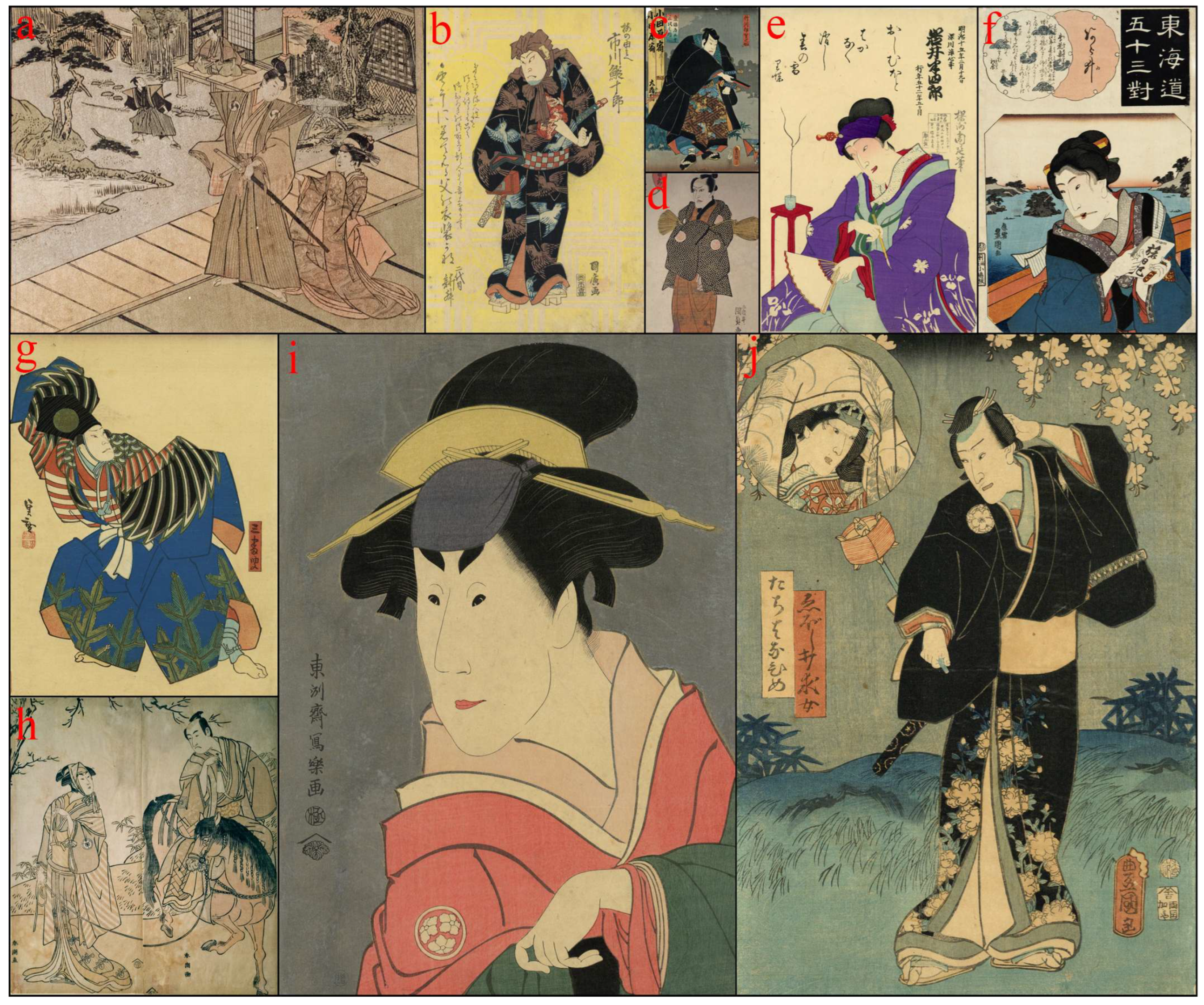
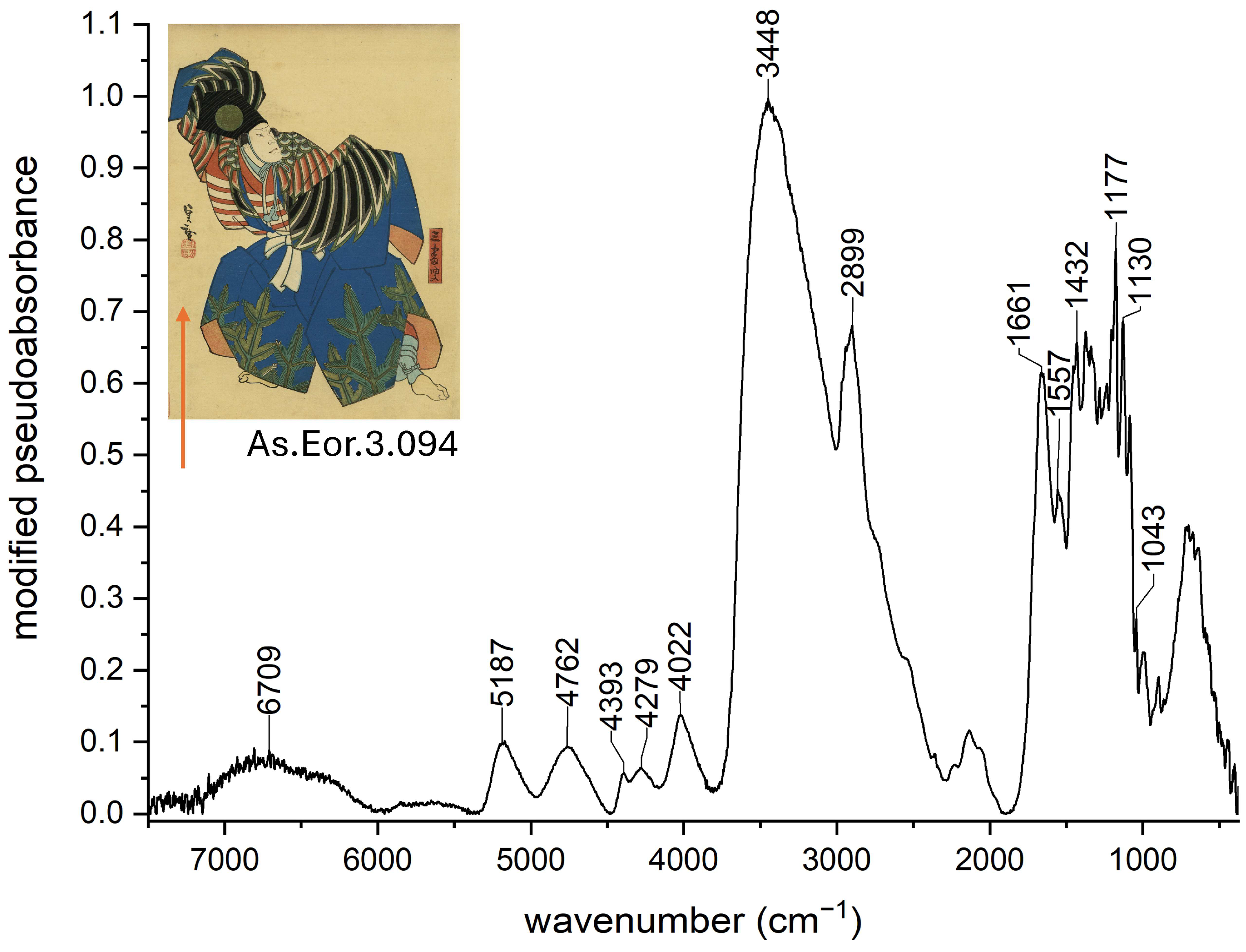
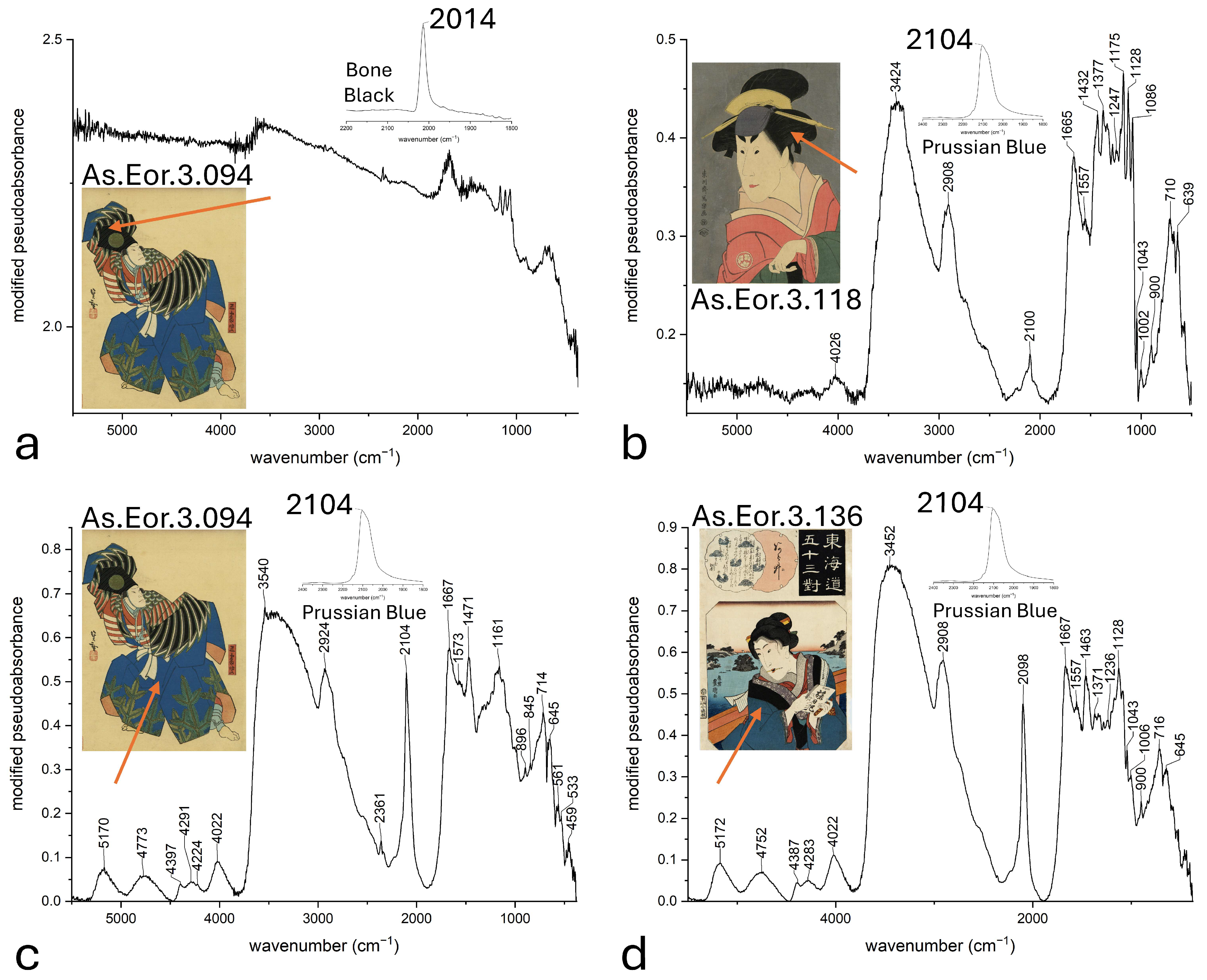
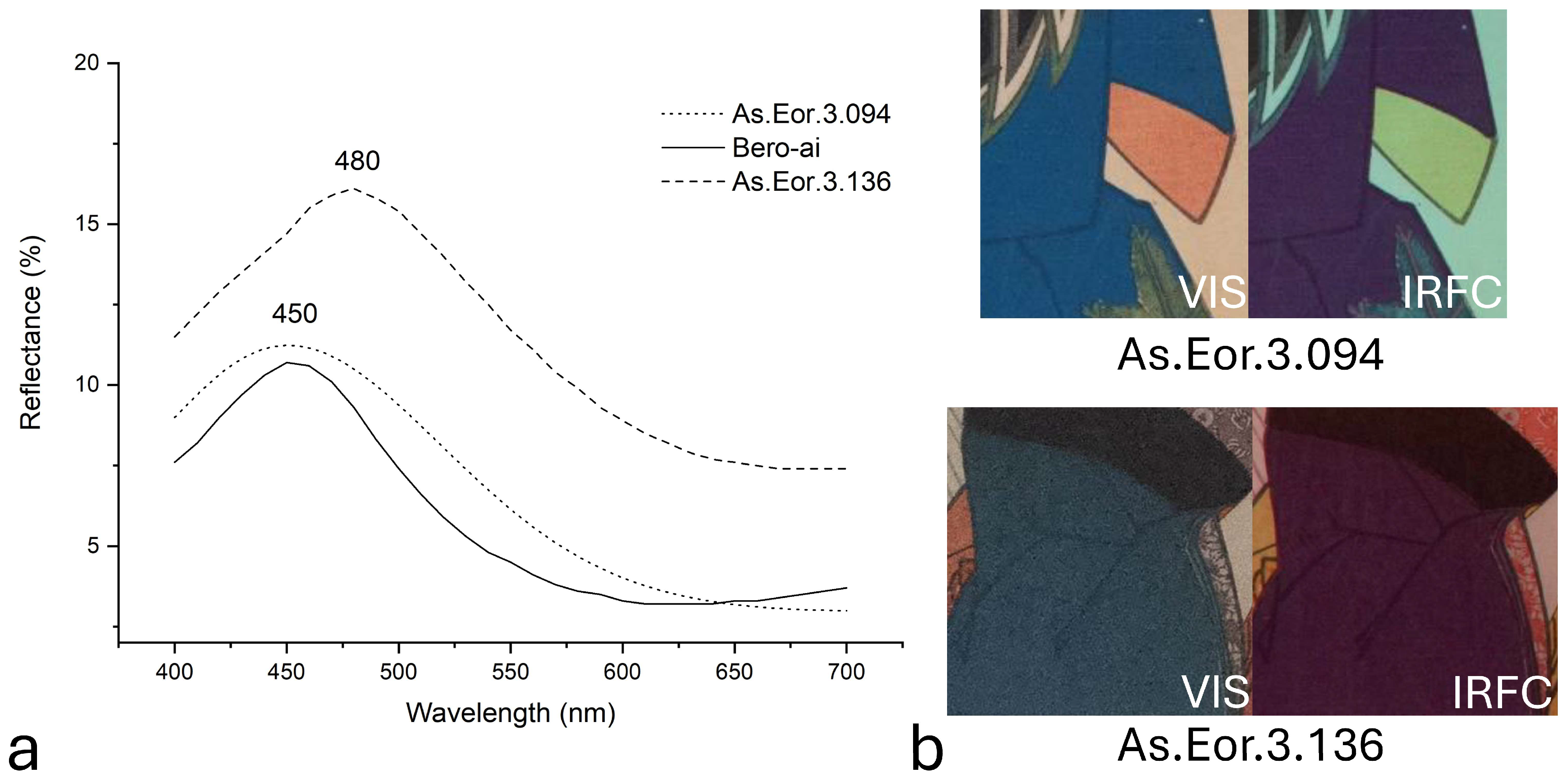


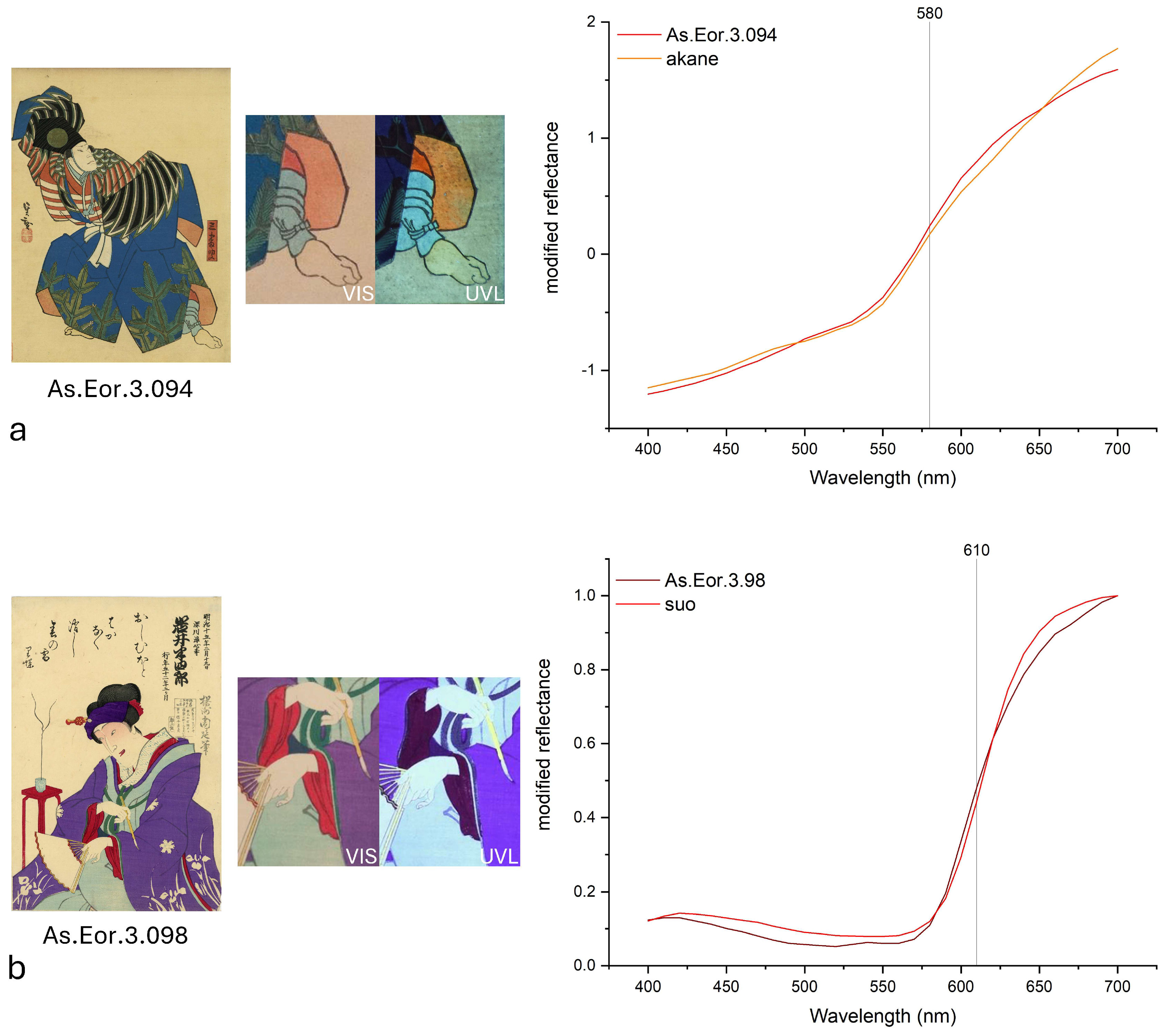
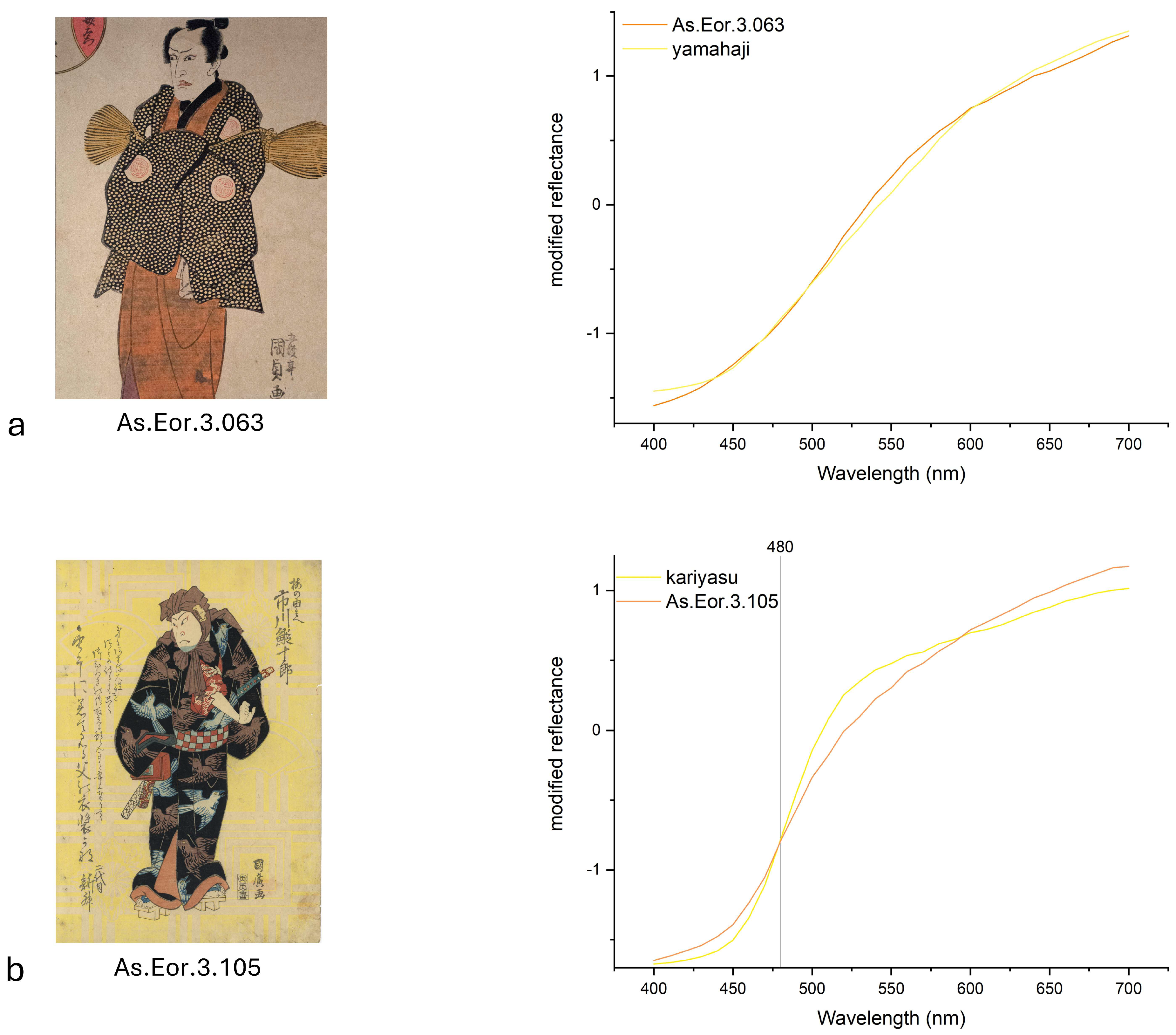


| Print Inventory Number | Painter, Year | Areas Analyzed |
|---|---|---|
| As.Eor.3.067 (Figure 1h) | Yushido Shuncho,1780–1796 | Green, grey, red |
| As.Eor.3.051 (Figure 1a) | Utagawa Toyokuni, 1812 | Green, grey, red, yellow |
| As.Eor.3.063 (Figure 1d) | Utagawa Kunisada, 1816 | Orange, red, yellow |
| As.Eor.3.105 (Figure 1b) | Utagawa Kunihiro, 1828 | Black, blue, brown, red, yellow |
| As.Eor.3.094 (Figure 1g) | Konishi (?) Hirosada, 1840 | Black, blue, green, red, white, yellow |
| As.Eor.3.136 (Figure 1f) | Utagawa Kunisada, 1845–1846 | Black, blue, red, white |
| As.Eor.3.169 (Figure 1c) | Utagawa Kunisada, 1854 | Black, brown, green, grey, red, yellow |
| As.Eor.3.083 (Figure 1j) | Utagawa Toyokuni III,1859 | Black, blue, yellow |
| As.Eor.3.098 (Figure 1e) | Toyohara Chikanobu, 1882 | Brown, green, purple, red |
| As.Eor.3.118 (Figure 1i) | Toshusai Sharaku, after 1906 | Black, green, grey, purple, red, white, yellow |
Disclaimer/Publisher’s Note: The statements, opinions and data contained in all publications are solely those of the individual author(s) and contributor(s) and not of MDPI and/or the editor(s). MDPI and/or the editor(s) disclaim responsibility for any injury to people or property resulting from any ideas, methods, instructions or products referred to in the content. |
© 2025 by the authors. Licensee MDPI, Basel, Switzerland. This article is an open access article distributed under the terms and conditions of the Creative Commons Attribution (CC BY) license (https://creativecommons.org/licenses/by/4.0/).
Share and Cite
Rampazzi, L.; Brunello, V.; Campione, F.P.; Corti, C.; Geminiani, L.; Recchia, S.; Luraschi, M. Identification of Materials and Kirazuri Decorative Technique in Japanese Ukiyo-e Prints Using Non-Invasive Spectroscopic Tools. Heritage 2025, 8, 349. https://doi.org/10.3390/heritage8090349
Rampazzi L, Brunello V, Campione FP, Corti C, Geminiani L, Recchia S, Luraschi M. Identification of Materials and Kirazuri Decorative Technique in Japanese Ukiyo-e Prints Using Non-Invasive Spectroscopic Tools. Heritage. 2025; 8(9):349. https://doi.org/10.3390/heritage8090349
Chicago/Turabian StyleRampazzi, Laura, Valentina Brunello, Francesco Paolo Campione, Cristina Corti, Ludovico Geminiani, Sandro Recchia, and Moira Luraschi. 2025. "Identification of Materials and Kirazuri Decorative Technique in Japanese Ukiyo-e Prints Using Non-Invasive Spectroscopic Tools" Heritage 8, no. 9: 349. https://doi.org/10.3390/heritage8090349
APA StyleRampazzi, L., Brunello, V., Campione, F. P., Corti, C., Geminiani, L., Recchia, S., & Luraschi, M. (2025). Identification of Materials and Kirazuri Decorative Technique in Japanese Ukiyo-e Prints Using Non-Invasive Spectroscopic Tools. Heritage, 8(9), 349. https://doi.org/10.3390/heritage8090349





